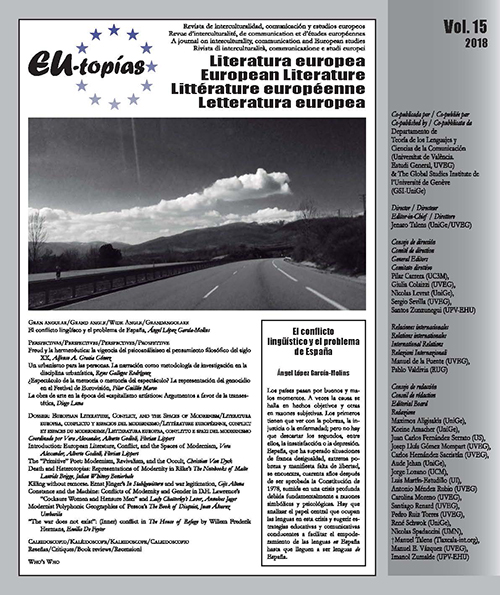Fernando Pessoa, modernism, space, Ricoeur
DOI:
https://doi.org/10.7203/eutopias.0.18581Keywords:
Fernando Pessoa, modernism, space, Ricoeur Abstract
Abstract
Fernando Pessoa’s The Book of Disquiet has recently become a landmark on the European modernist map. This paper proposes a spatial reading of TBOD through its three dislocalized categories of space: the identity who writes, the city it writes (Lisbon), and the books ultimately conformed by those writings. These spaces are placed in parallel with Paul Ricoeur’s three narrative categories proposed in Time and Narrative: prefiguration, configuration and refiguration. Pessoan spatial levels and Ricoeur’s three categories provide us with a basis to propose a cyclical spatial interpretation of TBOD. This paper aims to link the correspondences between different spatial levels of The Book, and to propose connections between spatial aspects of literature and the real world. In this case, for example, how a city can transform a book, and how a book can transform a city.
 Downloads
Downloads
 References
References
De Medeiros, Paulo (2015), O Silencio das Sereias: Ensaio sobre O livro do desasossego, Lisboa: Tinta da China.
Pessoa, Fernando (2015), Lisbon Disquiet, selected and edited by J. Pizzarro, translated by Margaret J. Costa, Lisboa: Tell a Story.
Pessoa, Fernando (2010), The Book of Disquiet, edited by Maria Jose de Lancastre, translated by Margaret J. Costa, London: Serpent’s Tail.
Pessoa, Fernando (2016). Eu Sou Uma Antologia: 136 Autores Fictícios, edited by Pizarro Jerónimo and Patricio Ferrari, Lisboa: Tinta-da-China.
Pizarro Jerónimo (2016a), “A ansiedade da unidade: uma teoria da ediçião”, LEA – Lingue e letterature d’Oriente e d’Occidente, 5, pp. 284-311.
Pizarro, Jerónimo (2016b), “Narciso ciego, iluminado por Lisboa (de Cesário Verde a Fernando Pessoa)”, Abriu, 5, pp. 35-50.
Ricoeur, Paul (1984), Time and Narrative Vol. I, translated by Kathleen MacLaughlin and David Pellauer, Chicago: University of Chicago Press.
Simmel, Georg (1969), “The Metropolis and Mental Life”, Richard Sennet (ed.), Classic essays on the Culture of Cities, New Jersey, Prentice Hall, pp. 11-19.
Sousa de Santos, Maria Irene Ramalho (2011), “The Tail of the Lizard: Pessoan Disquietude and the Subject of Modernity”, Jerónimo Pizarro & Steffen Dix (ed.), Portuguese Modernisms: Multiple Perspectives on Literature and the Visual Arts, London: Legenda, pp. 264-476.
Thacker, Andrew (2003), Moving through Modernity: Space and Geography in Modernism, Manchester: Manchester University Press.
Downloads
Published
How to Cite
-
Abstract171
-
PDF47
Issue
Section
License
![]()
The authors conserve the copyright. All content published in EU-topías. Journal of interculturality, Communication, and European Studies are subject to the license Creative Commons Attribution-NonCommercial-ShareAlike 4.0 license. The full text of the license can be found at <http://creativecommons.org/licenses/by-nc-sa/4.0>
They may be copied, used, disseminated, transmitted and publicly displayed, provided that:
- The authorship and original source of the publication is cited (journal, publisher and URL of the work).
- They are not used for commercial purposes.
- The existence and specifications of this license of use are mentioned.
It is the responsibility of the authors to obtain the necessary permissions for images that are subject to copyright.



